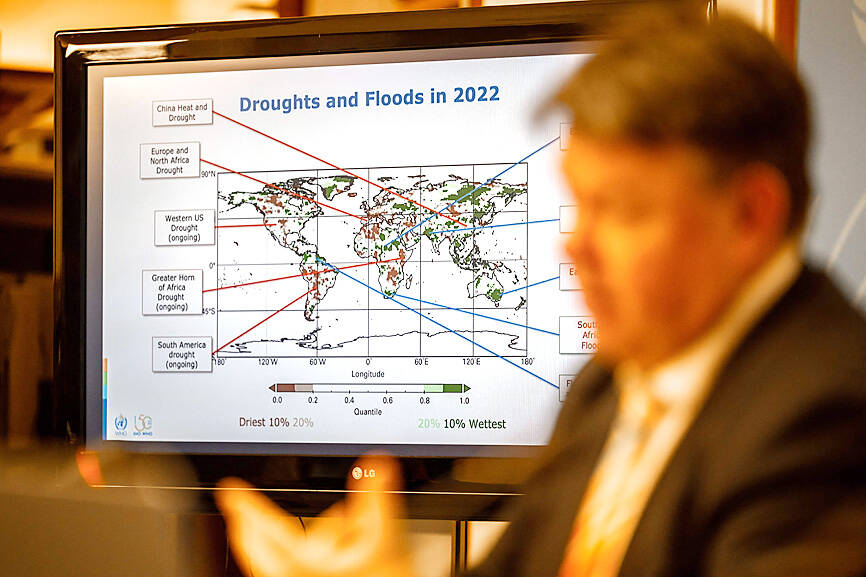Glaciers melted at dramatic speed last year and saving them is effectively a lost cause, the World Meteorological Organization (WMO) said on Friday, as climate change indicators once again hit record highs.
The past eight years have been the warmest ever recorded, while concentrations of greenhouse gases such as carbon dioxide hit new peaks, the UN agency said in a report.
“Antarctic sea ice fell to its lowest extent on record and the melting of some European glaciers was, literally, off the charts,” the organization said as it launched its annual climate overview.

Photo: AFP
Sea levels are also at a record high, rising by an average of 4.62mm per year between 2013 and last year — double the annual rate between 1993 and 2002.
Record high temperatures were also recorded in the oceans — where about 90 percent of the heat trapped on Earth by greenhouse gases ends up.
Under the 2015 Paris Agreement, countries agreed to cap global warming at “well below” 2°C above average levels measured between 1850 and 1900 — and 1.5°C if possible.
The global mean temperature last year was 1.15°C above the 1850-1900 average, the report said.
Record global mean temperatures over the past eight years came despite the cooling effects of a drawn-out La Nina weather phenomenon that stretched over nearly half that period.
The report said greenhouse gas concentrations reached new highs in 2021.
The concentration of carbon dioxide reached 415.7 parts per million globally, or 149 percent of the preindustrial (1750) level, while methane reached 262 percent and nitrous oxide hit 124 percent.
Data indicate they continued to increase last year.
WMO Secretary-General Petteri Taalas told a news conference that extreme weather caused by greenhouse gas emissions “may continue until the 2060s, independent of our success in in climate mitigation.”
“We have already emitted so much, especially CO2 in the atmosphere that this kind of phasing out of the negative trend takes several decades,” he said.
About 40 reference glaciers — those for which long-term observations exist — saw an average thickness loss of more than 1.3m from October 2021 to October last year — a loss much larger than the average over the past decade.
The cumulative thickness loss since 1970 amounts to almost 30m.
In Europe, the Alps smashed records for glacier melt due to a combination of little winter snow, an intrusion of Saharan dust in March last year and heat waves between May and early September last year.
“We have already lost the melting of the glaciers game, because we already have such a high concentration of CO2,” Taalas said.
In the Swiss Alps, “last summer we lost 6.2 percent of the glacier mass, which is the highest amount since records started.”
“This is serious,” he said, as the disappearance of the glaciers would limit freshwater supplies, and also harm transportation links if rivers become less navigable, calling it “a big risk for the future.”
“Many of these mountain glaciers will disappear, and also the shrinking of the antarctic and Greenland glaciers will continue for a long-term basis — unless we create a means to remove CO2 from the atmosphere,” he said.
Despite the report’s bad news, Taalas said there was cause for some optimism.
The means to battle climate change were becoming more affordable, he said, with renewable energy becoming cheaper than fossil fuels, while the world is developing better mitigation methods.

When Shanghai-based designer Guo Qingshan posted a vacation photo on Valentine’s Day and captioned it “Puppy Mountain,” it became a sensation in China and even created a tourist destination. Guo had gone on a hike while visiting his hometown of Yichang in central China’s Hubei Province late last month. When reviewing the photographs, he saw something he had not noticed before: A mountain shaped like a dog’s head rested on the ground next to the Yangtze River, its snout perched at the water’s edge. “It was so magical and cute. I was so excited and happy when I discovered it,” Guo said.

TURNAROUND: The Liberal Party had trailed the Conservatives by a wide margin, but that was before Trump threatened to make Canada the US’ 51st state Canada’s ruling Liberals, who a few weeks ago looked certain to lose an election this year, are mounting a major comeback amid the threat of US tariffs and are tied with their rival Conservatives, according to three new polls. An Ipsos survey released late on Tuesday showed that the left-leaning Liberals have 38 percent public support and the official opposition center-right Conservatives have 36 percent. The Liberals have overturned a 26-point deficit in six weeks, and run advertisements comparing the Conservative leader to Trump. The Conservative strategy had long been to attack unpopular Canadian Prime Minister Justin Trudeau, but last month he

Chinese authorities said they began live-fire exercises in the Gulf of Tonkin on Monday, only days after Vietnam announced a new line marking what it considers its territory in the body of water between the nations. The Chinese Maritime Safety Administration said the exercises would be focused on the Beibu Gulf area, closer to the Chinese side of the Gulf of Tonkin, and would run until tomorrow evening. It gave no further details, but the drills follow an announcement last week by Vietnam establishing a baseline used to calculate the width of its territorial waters in the Gulf of Tonkin. State-run Vietnam News

PROBE: Last week, Romanian prosecutors launched a criminal investigation against presidential candidate Calin Georgescu accusing him of supporting fascist groups Tens of thousands of protesters gathered in Romania’s capital on Saturday in the latest anti-government demonstration by far-right groups after a top court canceled a presidential election in the EU country last year. Protesters converged in front of the government building in Bucharest, waving Romania’s tricolor flags and chanting slogans such as “down with the government” and “thieves.” Many expressed support for Calin Georgescu, who emerged as the frontrunner in December’s canceled election, and demanded they be resumed from the second round. George Simion, the leader of the far-right Alliance for the Unity of Romanians (AUR), which organized the protest,